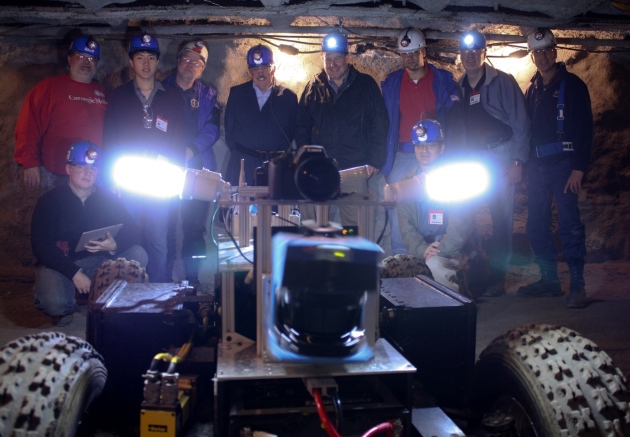Roaming robot may explore mysterious Moon caverns
November 19, 2012

William Whittaker’s cave-crawling robot could one day explore lunar caverns (credit: William Whittaker)
William ‘Red’ Whittaker often spends his Sundays lowering a robot into a recently blown up coal mine pit near his cattle ranch in Pennsylvania (see video below). By 2015, he hopes that his robot, or something like it, will be rappelling down a much deeper hole, on the Moon, Nature News reports.
“This is authentic exploration, this is the real deal,” says Whittaker, a roboticist at Carnegie Mellon University in Pittsburgh, Pennsylvania, whose robots have descended into an Alaskan volcano and helped to clean up the Three Mile Island nuclear power plant. “This is really going where none have gone before.”
Over the next two years, the NASA Innovative Advanced Concepts (NIAC) program will spend about US$500,000 developing Whittaker’s creations. The prototype he tested at the coal mine could be lowered into the Moon pit to check the walls for openings.
But a more ambitious approach would be a robot that jumps down the hole or lowers itself using a cable. The first prototype of such a machine, a four-wheeled Cave Crawler, can drive itself around underground and is already practising in the mine’s tunnels. Onboard lasers sweep the floors, walls and ceilings to map out the tunnels.
Protected Moon caves may house records of the history of the Moon and Solar System. Rocks that have been shielded from damage could look just like the surface did when it first cooled, or have textures that have been moulded by hidden processes going on inside the Moon, says Penelope Boston, a cave scientist and astrobiologist at the New Mexico Tech in Socorro. And solar-wind particles implanted billions of years ago could provide clues about the early evolution of the Sun, says van der Bogert.
Whittaker may soon have the means to put one of his robots on the Moon. His company, Astrobotic Technology in Pittsburgh, has signed a contract with SpaceX to launch a rocket that will carry robotic technology designed by Astrobotic to the Moon. The mission is competing for the Google Lunar X PRIZE — $20 million for the first privately funded team to land an autonomous vehicle on the Moon, move it 500 metres and send back data including videos.
In 2007, a team Whittaker led took first place in the Defense Advanced Research Projects Agency’s Grand Urban challenge, with a Chevrolet Tahoe that autonomously navigated city streets in California using technology similar to that in the Cave Crawler.